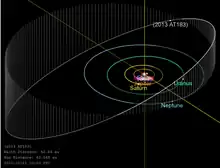 Orbit of 2013 AT183 | |
| Discovery[1] | |
|---|---|
| Discovered by | Pan-STARRS 1 |
| Discovery site | Haleakala Obs. |
| Discovery date | 26 January 2012 |
| Designations | |
| 2013 AT183 | |
| TNO[2] · SDO[3] · distant[1] | |
| Orbital characteristics[2] | |
| Epoch 27 April 2019 (JD 2458600.5) | |
| Uncertainty parameter 4 · 3[1] | |
| Observation arc | 20.20 yr (8,080 d) |
| Earliest precovery date | 29 January 2003[1] |
| Aphelion | 87.592 AU |
| Perihelion | 35.630 AU |
| 61.611 AU | |
| Eccentricity | 0.4217 |
| 483.61 yr (176,640 d) | |
| 68.884° | |
| 0° 0m 7.2s / day | |
| Inclination | 28.125° |
| 304.59° | |
| 68.292° | |
| Physical characteristics | |
Mean diameter | 160-799 km[2] |
| [2] | |
| 4.6[2] · 4.92[1] | |
(620074) 2013 AT183, or simply 2013 AT183 is a large trans-Neptunian object in the scattered disc, the outermost region of the Solar System. It was discovered on 26 January 2012 by the Pan-STARRS 1 sky survey at Haleakala Observatory, Hawaii.[1] First known precovery observation of (620074) 2013 AT183 was carried out in 29 January 2003.[1]
See also
References
- 1 2 3 4 5 6 7 "(620084) = 2013 AT183". Minor Planet Center. Retrieved 6 March 2019.
- 1 2 3 4 5 "JPL Small-Body Database Browser: (2013 AT183)" (2014-02-26 last obs.). Jet Propulsion Laboratory. Retrieved 6 March 2019.
- ↑ "List Of Centaurs and Scattered-Disk Objects". Minor Planet Center. International Astronomical Union. Retrieved 22 April 2023.
External links
This article is issued from Wikipedia. The text is licensed under Creative Commons - Attribution - Sharealike. Additional terms may apply for the media files.